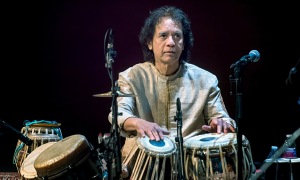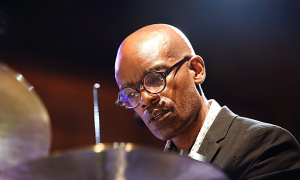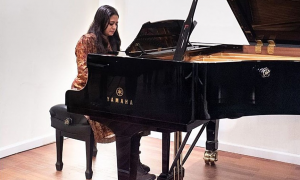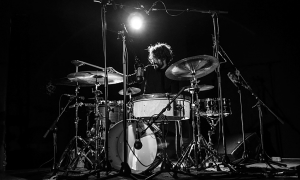Home » Jazz Articles » Under the Radar » Big in Japan: A History of Jazz in the Land of the Risin...
Big in Japan: A History of Jazz in the Land of the Rising Sun, Part 1

Foreigners may be more intrigued by the possibilities of ‘Japanese jazz’ than Japanese are.
—E. Taylor Atkins
The music market in Japan—second only to the U.S. in terms of revenue—generates more than two-billion dollars in sales annually. Enthusiasts and collectors of jazz recordings had long ago discovered that Japan's robust music scene, and the now virtual accessibility to products have made the country a go-to resource for hard-to-find releases. Among the Japanese pressings of American artists, various retail outlets offer vinyl rarities such as Oscar Peterson's Nigerian Marketplace (Jive, 1982), recorded in July 1981 at the Montreux Jazz Festival, the mono version of Erroll Garner Plays (Ember/Tokuma, 1976) or The Complete Keynote Collection (Nippon Phonogram, 1986). Included in this massive twenty-one LP box set are Coleman Hawkins, Teddy Wilson, Lennie Tristano, Lester Young, Benny Carter, Milt Hinton and Lionel Hampton; all mono recordings from the 1940s. One could also purchase Miles Davis' Sketches of Spain (Classic Records, 1994) for two-hundred and fifty US dollars.
The demand for Japanese market jazz recordings is based on a number of factors. Some Japanese manufactures claim that in the 1970s and 1980s American record labels frequently contracted with pressing companies that used recycled or cheap vinyl to press their records, resulting in poor sound quality. Toshiba—one of three major record manufacturers in 1950s Japan—began producing a number of red vinyl pressings. From the mid-1950s through the mid-1970s these so-called "Everclean" pressings were designed to be less susceptible to the build-up of static electricity and, thus, not as likely to accumulate dust. But the red vinyl discs were reserved for specific recordings, only a small number of which were reissues of American jazz albums. Special consideration for these pressings were also given to the most popular international rock bands of the time -The Beatles, Pink Floyd and so on. Still, the market for American jazz, inside of Japan, was—and continues to be—a lucrative one though the roots of jazz in that country have sturdy ties to its native artists.
Early Jazz in Japan
To understand the history of jazz in Japan, it is helpful to first look eighteen-hundred miles south to the Philippines; a country that was occupied by the US and later by Japan, from 1898 until 1946. A nationally famous pianist, Luis Borromeo, was sent as a child from his native island province of the Philippines to study music in the States. In 1915 he was coaxed into an impromptu performance at the San Francisco Pan-Pacific International Exposition, gaining the attention of a promoter. He was signed to a multi-year contract with the Orpheum Theater chain and toured with vaudeville-style stage shows in New York, Chicago, San Francisco, Seattle, and Portland. His trio included two Chinese-American singer/dancers and it became the highlight of the Orpheum stage shows. In 1920, Borromeo returned to the Philippines, now billed as "Borromeo Lou," and organized the first Filipino vaudeville company. In Chinese costumes, the trio performed a hybrid style of syncopated music that included jazz elements—introduced to the Philippines through the American military presence—and Asian influences as well. As Borromeo's act grew in popularity, he came to be known as the "King of Jazz" in his native country. During the American occupation of the Philippines, their trading activities with the Japanese grew enormously as did immigration between the two countries. Along with iron, copper and manganese, both counties were exposed to the other's musical cultural.The intermingling of African and Japanese cultures began before Japan had been formally established as a nation. Nubian, Berber, Moor, Copt and Zaghawa peoples from Northern and Central Africa were bringing their cultures—including their musical traditions—to the Asiatic Penninsula as far back as the Middle Ages. In his book The African American Encounter with Japan and China: Black Internationalism in Asia, 1895-1945 (The University of North Carolina Press, 2000), author Marc Gallicchio discusses the pre-World War II connections that were fostered between some Japanese academics and cultural figures in the African Americans community. The Japanese scholar, Yasuichi Hikida, was educated in the U.S. in the 1920s and 1930s and had established relationships with a number of prominent African-Americans of the Jazz Age, among them W. E. B. Du Bois, a leader of the Harlem Renaissance. The indirect connection would have provided Hikida a window into the jazz culture of Duke Ellington, Billie Holiday, Chick Webb and Louis Armstrong but it wasn't simply to his personal benefit. Hikida was an enigmatic character but one that the US Justice Department identified as a point man for a Japanese government operation to turn US blacks against their own government. The Japanese operatives attempted to position their nation as an independent country governed by people of color. Trying to create the illusion of a sympathetic ear in the Civil Rights movement, there is little to indicate that the Imperial government had long-term success influencing American blacks. Between 1937 and the attack on Pearl Harbor, it became evident that the US would eventually be pulled into a military conflict with Japan and so the operation faded away but not before relationships had been established.
The Japanese became aware of American jazz in the late 1920, but more through media like newsreels, recordings and sheet music rather than personal contact. Ocean liners from the West that stopped in Japanese ports often had dance bands but those musicians rarely ventured out onto land other than for the occasional hotel gigs that came their way. In a 2014 A Blog Supreme article, NPR's Patrick Jarenwattananon (How Japan Came To Love Jazz), interviewed E. Taylor Atkins, the author of Blue Nippon: Authenticating Jazz in Japan (Duke University Press, 2001). Atkins suggested that musicians from the Philippines—during its period as a U.S. colony—had developed some level of expertise in mirroring the American jazz players that they were exposed to more frequently than other Asians. The Filipino musicians played venues in a few Japanese and Shanghai locations and served as proxy for American performers. As had been the case in the U.S., jazz was not universally popular in Japan, whose musical history was steeped in the classics, folk music and non-western structures.
Following World War II, a rebuilding Japan embraced jazz to an even greater extent than before and by the 1950s and 1960s it was as popular as in Western Europe, more so depending on specific countries. However, the migration of black American musicians going on in Europe was muted by comparison in Japan. The U.S. occupied Japan from the mid-1940s into the early 1950s providing the opportunity for American musicians to present themselves to the Japanese market. Some did, and as Atkins points out, Cannonball Adderley felt like the pure human experience of playing in front of a Japanese audience had a physically intensity that was unique to the country. This is more remarkable considering the overall dispirited population being subjected to unwelcomed Americanization.
American jazz musicians, particularly top black artists, were migrating to Europe post-WW II, to escape racial discrimination in the U.S. Don Byas, Oscar Pettiford, Clifford Brown, Donald Byrd, James Moody, Bud Powell, Tadd Dameron, Kenny Clarke and Dexter Gordon were among the best-known expatriates in Western Europe. The names were less well-known, and the numbers smaller, but in the same time period there were U.S. musicians settling in Japan. Clarinetist Tony Scott and drummers J.C. Heard, who played with Cab Calloway, and Donald Bailey, a long-time member of Jimmy Smith's band migrated to Japan in the 1950s. According to Dr. Larry Ross, Professor of Sociology and Anthropology at Lincoln University, in his paper Jazz Musicians in Postwar Europe & Japan (McFarland & Company, 2001), Bailey found the Japanese to be even more color blind than Europeans. Ross says that Bailey was offered more work in Japan than he could manage and, just as importantly, he felt that the experience of living in Japan was intellectually and emotionally life changing. The presence of Americans—musical and political—further fueled the appetite for jazz.
In Blue Nippon, Atkins points out there was an almost complete obsession among Japanese jazz musicians to mimic the sound of their American contemporaries. The quality of a musician was judged not on his or her ability to improvise or to build cultural bridges, but on the musician's aptitude for impersonation. While this was largely the case in Europe as well, those countries were actively incorporating influences such as regional folk music, polka and gypsy music. It was not atypical to add an accordion or the balalaika to European versions of jazz. Some Japanese jazz musicians began to integrate native or Asian influences by the early 1960s but it was very limited. Much of Japanese jazz in the early 2000s sounds indistinguishable from its Western counterparts.
From the beginning of the American Jazz Age, Japan had staked its own claim to the music even as its musicians transparently copied U.S. artists. The Nitto Jass Band recorded the first Japanese jazz side "Walla Walla" (Nitto Records) in 1925. Soga Maoko and the Columbia Jazz Band (all native Japanese musicians) recorded at least one 78rpm side in 1929. As the band names indicate, these were groups that had been assembled by the record labels and Columbia, RCA and Warner all established Japanese subsidiaries. It would only be in the post-WW II years that Japanese musicians broke out as recognized players.
Pioneers
Louis Armstrong gave trumpeter Fumio Nanri the nickname "Satchmo of Japan." Nanri studied the piano with Teddy Weatherford while living in Shanghai in 1929. In 1932 he came to the U.S. and played venues from San Francisco to Florida but he remained a resident of China until the early 1940s when he was drafted into the Japanese military. One of the first Japanese jazz musicians to receive recognition beyond the Asian Peninsula, Nanri rose to prominence immediately after the war with a group called the Hot Peppers. A medical condition left him close to blindness in the early 1950s but he recovered and went on to play with Armstrong, Clark Terry and other Americans. Nanri, as typical of many Japanese musicians, favored the Dixieland style though he briefly flirted with bebop. He died in 1975 shortly after he had organized and played in a concert to show support for the people of Vietnam.From the late 1950s on, Japan turn out an increasing number of native musicians, some of whom received global recognition. Drummer Hideo Shiraki was a rising star on the Tokyo jazz scene of the 1950s and 1960s. His quintet of that period was arguably the most popular in the country. He met Art Blakey while visiting New York in 1962 and the American drummer convinced Shiraki to perform at Birdland, but failed to persuade him to relocate to New York. Shiraki was one of Japan's early adapters in moving toward hard bop while simultaneously working in the traditional setting of a koto quartet. His own quintet featured some of the top talent in Japan including trumpeter Terumasa Hino, drummer George Kawaguchi and trombonist Akira Fukuhara. After playing the Berlin Jazz Festival in 1965 those members left to pursue solo careers in rapid succession and Shiraki's star began to fade. He left music and disappeared from public life until his death from a drug overdose in 1972. Widely believed to be a case of suicide, Shiraki was thirty-nines years of age.
Composer/arranger, bandleader and pianist Toshiko Akiyoshi has been nominated for fourteen Grammys and won numerous other awards and prestigious polls. Though she was born in Manchuria her Japanese parents returned to their country following the end of WW II. Akiyoshi's first exposure to jazz was hearing a recording of Teddy Wilson, an experience that led her to formally study the genre. When Oscar Peterson heard her playing in a club in the Ginza district of Tokyo, he urged producer Norman Granz to sign her. Granz teamed Akiyoshi with Peterson's rhythm section of guitarist Herb Ellis, bassist Ray Brown and drummer J.C. Heard for Toshiko's Piano (Norgran Records, 1954). In Japan the album was titled Amazing Toshiko Akiyoshi and released on Verve Records. It took one year for Akiyoshi to cut through U.S. State Department red tape to be able to attend the Berklee School of Music as their first Japanese student. Akiyoshi married saxophonist Charlie Mariano in 1959, was divorced and later married saxophonist Lew Tabackin. The pair assembled a sixteen-piece jazz orchestra in Los Angeles in 1973.
The debut release from the Toshiko Akiyoshi-Lew Tabackin Big Band was Kogun (RCA, 1974) and like a number of their subsequent releases it followed a specific theme. The album was inspired by the story of a Japanese soldier who was lost in the jungle of Southeast Asia for nearly three decades following WW II. The soldier believed that the war was still being fought. Despite the subject matter, the music itself was firmly rooted in American big band swing style. It was for that very reason that many of Akiyoshi's ensemble releases were only available in the U.S. as imports; major labels felt that the style had passed its prime in the western market. Yet years later, with Hiroshima: Rising from the Abyss (True Life Jazz, 2002), some critics felt that the incorporation of Japanese elements (limited, at best) in the big band setting, might be off-putting to American listeners. Still, Hiroshima was well-received and Akiyoshi—nearing the end of a five-year residency at Birdland—had become one of the most recognized talents to come out of Japan. By the mid-1970s Akiyoshi's music began to utilize themes and touches that reflected her heritage. Japanese harmonies and—to a smaller extent—instruments such as the utai, tsugaru and shamisen where infused with the American influences.
Saxophonist Sadao Watanabe is among the best known of the early (and current) home-grown artists. His performing career began in 1953 but in 1962 he came to the U.S. to attend Berklee College. By all measures, Watanabe has been one of the most successful international jazz artists; his music placed high on the charts and sold well inside and outside his country. He has recorded more than seventy-five albums as a leader, ranging from mainstream to fusion, sometimes with strings. From Watanabe's earliest recordings in the 1960s to his most recent in 2017, a listener would be hard-pressed to identify Japanese influences. Watanabe's longevity has made his groups jumping-off points for a number of successful Japanese artists. For some critics he embodied the sense that Japanese jazz was simply derivative. Drummer Keiji "George" Otsuka began playing Watanabe's quartet in the late 1950s. He led his own trio and worked with a drum ensemble project with Roy Haynes, Jack DeJohnette, and Mel Lewis. Otsuka was a first call drummer for many touring artists in Japan, including Elvin Jones, John Scofield, Miroslav Vitous, Phil Woods, and Reggie Workman. Another Watanabe associate was double bassist Masanaga Harada, a regular in Tokyo from the 1950s forward. Harada primarily played with top Japanese artists but had also recorded with Hank Jones and appeared on more than seventy albums.
Atkins makes an important observation regarding the Americanization of jazz in Japan. Stating that ..."foreigners may be more intrigued by the possibilities of 'Japanese jazz' than Japanese are. In the documentary Tokyo Blues, trumpeter Mike Price, a veteran of Akiyoshi-Tabackin orchestra...expresses a desire to incorporate traditional Japanese aesthetic principles into his jazz;" Atkins continues, citing Asian American jazz artists such as John Jang and Francis Wang who have made similar efforts. Nevertheless, in the 1960s Japanese jazz was taking on increased disparagement for its lack of national identity, at the same time that the genre was taking a back seat to the Beatles and the Rolling Stones as well as American groups such as The Beach Boys. Japanese rock was quicker to develop home-grown hybrids and so-called J-pop and J-rock bands rode the movement of rock into new wave and synthesizer-pop with groups like Yellow Magic Orchestra and the Southern All Stars. Not only did younger Japanese fans more closely identify with this music but, in a reverse trend, other regions of Southeast Asia began to copy the Japanese styles. But jazz music remained relatively popular throughout this period and experienced a revitalization by the late 1990s. A new breed of Japanese jazz musician is emerging with talents such as guitarist May Inoue, drummer Shun Ishiwaka, trumpeter Shinpei Ruike and bassist Takumi Moriya having made break-out contributions. Big in Japan, Part 2, will look at the life and career of Osaka, Japan native and New York City resident Eri Yamamoto whose move west in 1995 marked the beginning of the celebrated career of one of the most diverse trio leaders on the downtown scene.
Recordings of Interest
Sadao Watanabe How's Everything (Cherry Red Records, 2008)
How's Everything (Cherry Red Records, 2008) Watanabe began recording with American jazz musicians early in his career when he and Charlie Mariano released Iberian Waltz (Denon, 1967). By the mid-1970s he was well entrenched in the fusion sub-genre and working with Harvey Mason, Lee Ritenour, Michael Brecker, Steve Gadd, George Benson and many others in that category.
Keyboard player Richard Tee, Gadd, guitarist Eric Gale, Ralph MacDonald, Anthony Jackson, Jeff Mironov and Dave Grusin made up Watanabe's all-star fusion band on How's Everything. Recorded in 1980 at Tokyo's famous Nippon Budokan, the double album was originally issued by Columbia and captures two nights' highlights. Grusin is a major factor here, conducting and arranging for The Tokyo Philharmonic Orchestra which appears on a few tracks; he also contributes two of his own compositions. Those pieces, "All About Love" and "Sun Dance" had appeared on a Grover Washington, Jr. album featuring Grusin and sound almost indistinguishable from the Watanabe versions. There is little on How's Everything that is noteworthy and some of the numbers are overly busy and distracting. This is one that is strictly meant for fusion fans who lean toward smooth jazz.
Toshiko Akiyoshi Jazz Orchestra featuring Lew Tabackin
 Hiroshima: Rising from the Abyss (True Life Jazz, 2003)
Hiroshima: Rising from the Abyss (True Life Jazz, 2003) Conceptually and musically the Toshiko Akiyoshi Jazz Orchestra's Hiroshima: Rising from the Abyss is a challenging and thought-provoking experience. Several years before the album was recorded (in a live setting) in 2001, Akiyoshi had received a request from Buddhist monks to compose a memorial to the near obliteration of Hiroshima. Her suite—six tracks bookended by loosely related pieces—was meant as a definitive anti-war statement. And it succeeds on multiple levels.
In a cycle of musical emotions, Akiyoshi takes us from the energy of a large, modern city, to the horror of its atomic bombing in 1945, to the slowly developing hopefulness of rebuilding structures and lives. The primary soloists throughout the album are Akiyoshi and Tabackin with drummer George Kawaguchi and Won Jang-Hyun on Korean flute joining as guests of the large ensemble. Jang-Hyun, in particular, lends some authentic Japanese flavor to an otherwise traditional big band formula. More impactful are the verbal readings from the diaries of Hiroshima survivors. These "Survivor Tales," are taken from a collection titled "Mother's Diaries" and are positioned throughout the second movement of the suite.
Eri Yamamoto photograph courtesy of Dave Kaufman
< Previous
The Stylings Of Champian
Comments
Tags
Under the Radar
Karl Ackermann
oscar peterson
Erroll Garner
Coleman Hawkins
Teddy Wilson
Lennie Tristano
Lester Young
Benny Carter
Milt Hinton
Lionel Hampton
Miles Davis
The Beatles
Pink Floyd
duke ellington
Billie Holiday
Chick Webb
Louis Armstrong
Julian "Cannonball" Adderley
Don Byas
Oscar Pettiford
Clifford Brown
Donald Byrd
James Moody
Bud Powell
Tadd Dameron
Kenny Clarke
Dexter Gordon
Tony Scott
Cab Calloway
Donald Bailey
Jimmy Smith
Teddy Weatherford
Clark Terry
Art Blakey
Terumasa Hino
Toshiko Akiyoshi
Norman Granz
Herb Ellis
Ray Brown
J. C. Heard
Charlie Mariano
lew tabackin
Sadao Watanabe
Roy Haynes
Jack DeJohnette
Mel Lewis
Elvin Jones
John Scofield
Miroslav Vitous
Phil Woods
Reggie Workman
Hank Jones
Eri Yamamoto
Harvey Mason
Lee Ritenour
Michael Brecker
Steve Gadd
george benson
Richard Tee
Eric Gale
Ralph MacDonald
Anthony Jackson
Jeff Mironov
Dave Grusin
Grover Washington, Jr.
For the Love of Jazz
 All About Jazz has been a pillar of jazz since 1995, championing it as an art form and, more importantly, supporting the musicians who create it. Our enduring commitment has made "AAJ" one of the most culturally important websites of its kind, read by hundreds of thousands of fans, musicians and industry figures every month.
All About Jazz has been a pillar of jazz since 1995, championing it as an art form and, more importantly, supporting the musicians who create it. Our enduring commitment has made "AAJ" one of the most culturally important websites of its kind, read by hundreds of thousands of fans, musicians and industry figures every month.






















